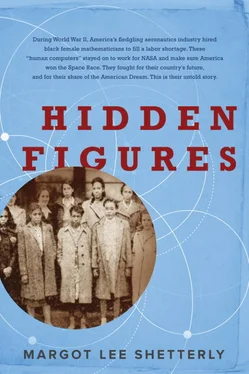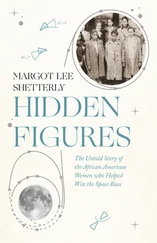So, too, was A. Philip Randolph. The leader’s indefatigable activism, unrelenting pressure, and superior organizing skills laid the foundation for what, in the 1960s, would come to be known as the civil rights movement. But there was no way that Randolph, or the men at the laboratory, or anyone else could have predicted that the hiring of a group of black female mathematicians at the Langley Memorial Aeronautical Laboratory would end at the Moon.
Still shrouded from view were the great aeronautical advances that would crush the notion that faster-than-sound flight was a physical impossibility, the electronic calculating devices that would amplify the power of science and technology to unthinkable dimensions. No one anticipated that millions of wartime women would refuse to leave the American workplace and forever change the meaning of women’s work, or that American Negroes would persist in their demands for full access to the founding ideals of their country and not be moved. The black female mathematicians who walked into Langley in 1943 would find themselves at the intersection of these great transformations, their sharp minds and ambitions contributing to what the United States would consider one of its greatest victories.
But in 1943, America existed in the urgent present. Responding to the needs of the here and now, Butler took the next step, making a note to add another item to Sherwood’s seemingly endless requisition list: a metal bathroom sign bearing the words COLORED GIRLS.
There was no escaping the heat in the summer of 1943, not in the roiling seas of the South Pacific, not in the burning skies over Hamburg and Sicily, and not for the group of Negro women working in Camp Pickett’s laundry boiler plant. The temperature and humidity inside the army facility were so intense that slipping outdoors into the 100-plus degrees of the central Virginia June summer invited relief.
The laundry room was both one of the war’s obscure crannies and a microcosm of the war itself, a sophisticated, efficient machine capable of processing eighteen thousand bundles of laundry each week. One group of women loaded soiled laundry into the enormous boilers. Others heaved the sopping clothes into the dryers. Another team worked the pressing machines like cooks at a giant griddle. Thirty-two-year-old Dorothy Vaughan stood at the sorting station, reuniting wayward socks and trousers with the laundry bags of the black and white soldiers who came to Camp Pickett by the trainload for four weeks of basic training before heading on to the Port of Embarkation in Newport News. Small talk of husbands, children, lives back home, or the ever-present war rose above the thunder and hum of the giant laundry boilers and dryers. We gave him a real nice send-off, whole neighborhood turned out. Just as well you can’t get stockings nowhere, hot as it is . That Mr. Randolph sure is something, and friends with Mrs. Roosevelt too! They brooded over the husbands and brothers and fathers heading into the conflict that was so far away from the daily urgencies of their lives in Virginia, yet so close to their prayers and their dreams.
The majority of the women who found their way to the military laundry room had left behind jobs as domestic servants or as stemmers in the tobacco factories. The laundry was a humid inferno, the work as monotonous as it was uncomfortable. Laundry workers existed at the bottom of the war’s great pyramid, invisible and invaluable at the same time. One aircraft industry executive estimated that each laundry worker supported three workers at his plants; with someone else to tend to their dirty clothing, men and women on the production lines had lower rates of absenteeism. The laundry workers earned 40 cents an hour, ranking them among the lowest paid of all war workers, but with few job options available to them, it felt like a windfall.
Only a week had elapsed between the end of the school year at Robert Russa Moton, the Negro high school in Farmville, Virginia, where Dorothy worked as a math teacher, and her first day of work at Camp Pickett. As a college graduate and a teacher, she stood near the top of what most Negro women could hope to achieve. Teachers were considered the “upper level of training and intelligence in the race,” a ground force of educators who would not just impart book learning but live in the Negro community and “direct its thoughts and head its social movements.” Her in-laws were mainstays of the town’s Negro elite. They owned a barbershop, a pool hall, and a service station. The family’s activities were regular fodder for the social column in the Farmville section of the Norfolk Journal and Guide , the leading Negro newspaper in the southeastern United States. Dorothy, her husband, Howard, and their four young children lived in a large, rambling Victorian house on South Main Street with Howard’s parents and grandparents.
In the summer of 1943, Dorothy jumped at the chance to head to Camp Pickett and earn extra money during the school break. Though teaching offered prestige, the compensation was modest. Nationally, Virginia’s white teachers ranked in the bottom quarter in public school salaries, and their black counterparts might earn almost 50 percent less. Many black teachers in the South gave lessons in one- or two-room schools that barely qualified as buildings. Teachers were called upon to do whatever was necessary to keep the schoolhouses clean, safe, and comfortable for pupils. They shoveled coal in winters, fixed broken windows, scrubbed dirty floors, and prepared lunch. They reached into their own threadbare purses when the schoolroom kitty fell short.
Another woman in Dorothy’s situation might have seen the laundry job as unthinkable, regardless of the economics. Wasn’t the purpose of a college degree to get away from the need to work dirty and difficult jobs? And the location of the camp, thirty miles southeast of Farmville, meant that she lived in worker housing during the week and got back home only on weekends. But the 40 cents an hour Dorothy earned as a laundry sorter bested what she earned as a teacher, and with four children, a summer of extra income would be put to good and immediate use.
And Dorothy was of an unusually independent mind, impatient with the pretensions that sometimes accompanied the upwardly mobile members of the race. She did nothing to draw attention to herself at Camp Pickett, nor did she make any distinctions between herself and the other women. There was something in her bearing that transcended her soft voice and diminutive stature. Her eyes dominated her lovely, caramel-hued face—almond-shaped, wide-set, intense eyes that seemed to see everything. Education topped her list of ideals; it was the surest hedge against a world that would require more of her children than white children, and attempt to give them less in return. The Negro’s ladder to the American dream was missing rungs, with even the most outwardly successful blacks worried that at any moment the forces of discrimination could lay waste to their economic security. Ideals without practical solutions were empty promises. Standing on her feet all day in the sweltering laundry was an opportunity if the tumbled military uniforms bought new school clothes, if each sock made a down payment on her children’s college educations.
At night in the bunk of the workers’ housing, as she willed a breeze to cut through the motionless night air, Dorothy thought of Ann, age eight, Maida, six, Leonard, three, and Kenneth, just eight months old. Their lives and futures informed every decision she made. Like virtually every Negro woman she knew, she struggled to find the balance between spending time with her children at home and spending time for them, for her family, at a job.
Читать дальше
Конец ознакомительного отрывка
Купить книгу












